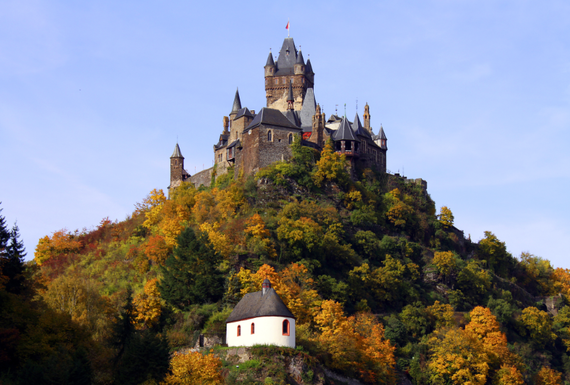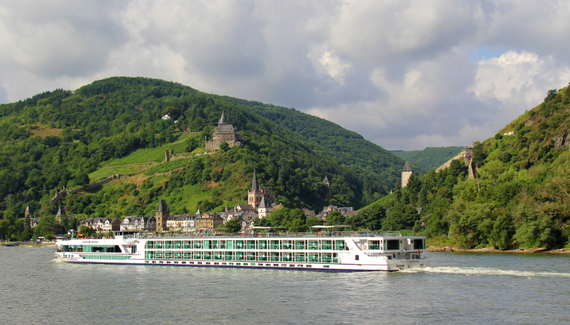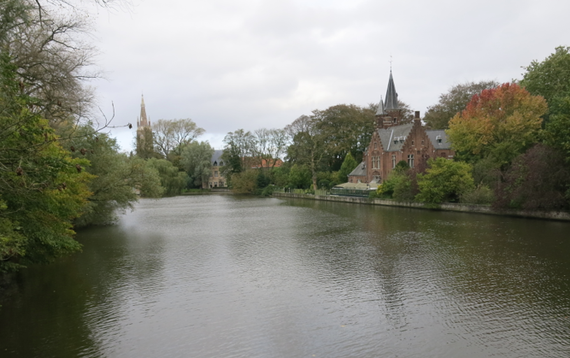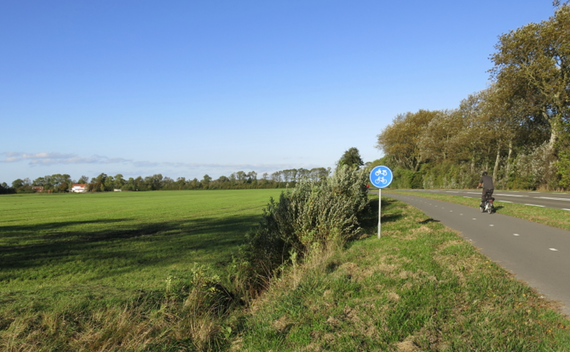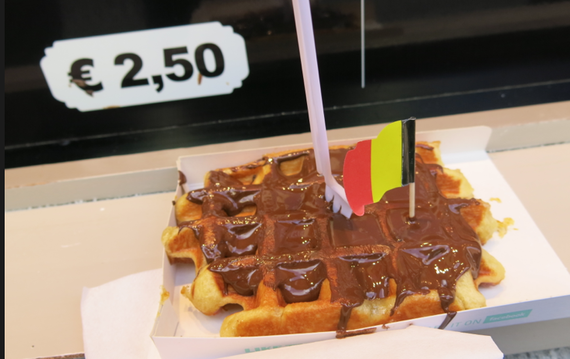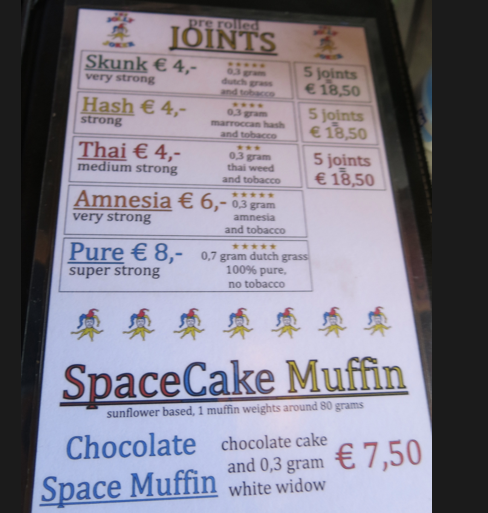I hate cruises. I only go by ship if there is no other way to get to a place -- like traveling around Antarctica or the Amazon Rain Forest. But here I was, snuggled next to my man on the sundeck of the Scenic Diamond river cruiser, watching the world go by. We were sailing alongside fairytale villages with centuries-old half-timbered houses and churches, we slipped past medieval castles high on the hills and floated alongside the steep-slopes of verdant Moselle Valley vineyards. When a waiter appeared on deck to ask if we'd like a cocktail, I knew it couldn't get any better.
I never thought I'd be able stand more than three days on a boat. I'm active. I like to run and go to the gym. When Jamie and I were looking for a romantic getaway to celebrate our one-year anniversary, we didn't even consider a cruise. But when we settled on seeing the Black Forest, Bruges and Amsterdam, the thought of driving through Germany, Belgium, and the Netherlands, following road maps, booking endless hotels, constantly packing and unpacking, and figuring out where to eat each night took the excitement away out of what was supposed to be a relaxing getaway.
Then a friend told us about Scenic Tour's "Romantic Rhine & Moselle Luxury River Cruise." The itinerary included our wish list plus places such as Strasbourg, Cochem and Antwerp. It included all meals, snacks, mini-bar, complimentary drinks any time of day, electric bicycles, a personal butler, and all gratuities. Suddenly a cruise didn't sound like such a bad idea. And this 85-cabin cruise ship wasn't even called a river cruiser -- it was called a spaceship because it was so airy and high-tech. With the push of a button, you could convert your private full-size balcony into a "sun lounge." We booked it, though I wondered if I'd survive Day 4 on a boat.
It turned out that life on board the Scenic Diamond was like life at a resort. We were wined and dined, even in the morning, when sparkling wine was offered with the sumptuous buffet. Breakfast and lunch included both buffets and a menu with unlimited choices. Dinner was in one of three restaurants, two which included five-course dinners with wine pairings. There was also a River Café with sandwiches, snacks, and pastries available 24 hours a day. The open bar was fully stocked and there were daily cocktail specials. Best, everything was included.
Fortunately, there was a sundeck with an oval track, perfect for early morning laps. You might think running laps on a boat would be difficult, but this cruiser was so smooth I wouldn't have known we were moving if we weren't passing barges and other water craft. Every time a boat came alongside, I'd wave and then race from the bow to stern trying to beat them. They always won, but it made running laps much more interesting. If there weren't passing boats, there were other things to watch: vineyards or farms or forests or castles.
Each day there were different tour options with local guides who spoke excellent English. You could also choose to go independently. Every one of he 121 passengers was outfitted with a Tailormade GPS guided tour device, smaller than a Nook and complete with an earpiece. You'd scroll down to choose a specific castle or church or courtyard, hit the button, and listen to as much or as little as you wanted. You could stop the narration and change the subject whenever you wanted.
What Jamie and I liked best were the electric bicycle tours. There were always two biking guides (one lead and one sweep), and we used our GPS devices as we peddled along. We could hear the guide's voice through the earpiece, which meant not having to stop every minute. Just as good was the bike's electric assist. If you were ascending a hill, you'd hit a button on your handlebar, and suddenly the bike would do all the work. Pressing anywhere from 1 for a gentle assist to 6 for full force, you'd fly up the hill effortlessly.
The bikes covered much more distance so we could see much more of each city. There were also times when we'd take a bike ride into the countryside such as when we peddled past the tiny centuries-old Netherland city of Mook. "Go on," said Wernie, the cruise director. "You have time for a ride before lunch." He pointed out the direction, we hopped on the bikes and peddled to a country lane passing cows and sheep, then through a dirt road in the forest, out to a sleepy harbor, and then we raced each other back to the ship, screaming like kids.
Often we joined the guided walking tours because good tour guides give you information you can't find elsewhere. In Cochem, a German guide told us that if there's a rooster on the steeple, it is a Catholic Church (the rooster was a symbol that announced the dawn of a new age in the midst of darkness). A Dutch guide told us that Bette Midler said Dutch isn't a language, it's a gum disease. And then she did a kind of Peter-Piper-picked-a-pair-of-pickled-peppers imitation in Dutch, which sounded like someone spitting up phlegm.
A guide escorting us on a tour of Antwerp said as we passed by a McDonalds, "That's the American Embassy." The Netherlands is known as the lowlands: "Pull up a chair, stand on it and you'll see the country," she told us. We learned there used to be 10,000 windmills; now there are 900, and the windmills create their own language based on the positioning of the blades. If the blade is not moving and looks like an X, it means the farmer is taking a two- to three-week holiday. A "T" position means he is taking only 1-2 days rest. The Allies used the position of the blades to communicate with each other and to confuse the Germans during World War II.
The Dutch brought "Sinta Klaus" to America. "You Americans turned it into Christmas," said one guide; "but in Holland it's Black Piet, Sinta's helper, who comes down the chimney on December 5th and gets sooty, so that's why he's called Black Piet. Now some people are saying it's politically incorrect and they want to ban Black Piet. Come on, we lost our guilders already. We don't want to lose our culture."
In Germany, we tried every kind of sausage sold. In Belgium, we ate chocolate waffles and chocolates by the pieces, tried the world-famous mussels and savory Belgium French Fries. And of course we tasted the local brews and local wines
A guide told us that Arnold Schwarzenegger came to Belgium for a bodybuilding contest, heard people talking about muscles, and thought everyone was talking about him. But they weren't -- they were talking about the mussels. In Holland, we ate raw herring from a vendor whose sign read "A Herring A Day Keeps the Doctor Away." We biked through the quaint town of Veere and then to a dairy farm for fresh unpasteurized milk and cow's cheese. We visited The Rubens House in Antwerp, which he built to resemble an Italian palazzo, and where he lived and worked until his death 1640.
In Amsterdam, kids learn to ride bikes before they can walk, and you have to look both ways crossing the street because it's as bad as trying to cross in Saigon. We went to the Rijksmuseum and stood mesmerized by Rembrandt's Nightwatch and all the famous Dutch masters.
And then we entered a coffee shop, "The Jolly Joker," which we soon learned was not to be confused with a café. Coffee shops in Amsterdam haven't served coffee since the '70s: They serve "soft" drugs. The waiter handed us a menu with a list of pre-rolled joints varying in strength from mild to super strong. We left and returned to our private sundeck on board and continued to watch the world go by.
